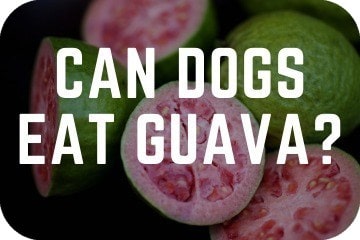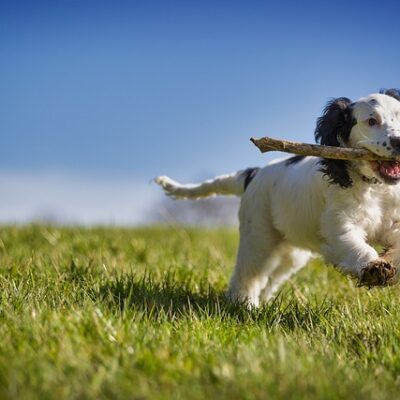Can Dogs Eat Guava? Yes, dogs can eat Guava! As with all ‘human’ foods, dogs should be given guava in moderation. Guava is highly nutritious and provides dogs with beneficial vitamins and minerals. However, guava is also high in carbohydrates and sugars. Therefore it should only be given as a small treat.
Busy? Get Your Hands Paws On The Answers Quickly…
- Can Dogs Have Guava?
- What Are The Different Types Of Guava?
- What Fruits Are Best For Dogs?
- Fun Fruit Games For Dogs
- FAQs
CAN DOGS HAVE GUAVA?
As we mentioned above, dogs can have guava fruit. Below we have outlined the nutrients, vitamins, and minerals that guava has and why they’re good for your dog. There are also some health concerns or precautions you should take when feeding guava, take a look!
Health Benefits
Fiber
Monitoring your dogs’ fiber intake isn’t a necessity. However, moderate levels of fiber have shown to help with a dog’s digestive system. As well as this, dietary fiber is also suitable for maintaining weight. If your dog is on a weight loss regime and you find they’re still hungry after their meal, adding more fiber to their diet will make them feel full for longer.
Vitamin A
Guava helps provide your dog with vitamin A. Vitamin A is vital for your dog as it helps to improve and maintain their optimal health. Vitamin A also helps to keep your dogs skin, coat muscles, and nerves in working order; without this vital vitamin, dogs will become lethargic and seriously ill. Other foods high in vitamin A include; carrots, spinach, pumpkin, and sweet potatoes.
Vitamin C
This vitamin is of high importance. The antioxidants help reduce inflammation inside the dogs’ body as well as helping with cognitive aging. Dogs’ can produce vitamin C in their liver, but that does not mean you should factor it out of their diet as it offers other health benefits. Other foods high in vitamin C include; broccoli, sprouts, lychees, and lemons.
Potassium
High levels of potassium can be provided from guava. Potassium is an excellent nutrient for your dogs as it helps to control their nerve impulses, functions the brain, muscle activity, and function of the heart. If your dogs’ potassium levels become too low, it can cause hypokalaemia. Hypokalaemia can affect some dogs a lot, while others won’t show any symptoms. The lack of potassium can affect a dog’s neurological, skeletal, and cardiac muscles, and if left untreated, it could be fatal.
Magnesium
Magnesium is another mineral that can be found in guava. Magnesium is a natural relaxant that is highly beneficial for dogs with muscle aches and pains (especially older dogs with arthritis). Magnesium acts helps to soothe the sore muscles and joints, easing the level of pain.
Health Concerns
Allergic Reaction!
As with all foods that are new to your dog, it poses the potential risk that your dog may be allergic to them. It is best to start by feeding your dog a smaller portion of guava and then monitor their behavior that follows to see if they show any signs of an allergic reaction (see below).
Allergic Reaction Symptoms:
> Vomiting
> Swollen & Red Lips
> Diarrhea
> Loss of Appetite
> Lethargic When Moving
> Seizures
If your dog is showing any of these symptoms. Call your veterinarian straight away to find out the procedures that follow.
Choking Hazard
The pulp of the guava is the best part to feed your dog. Ensure you remove the rind, leaves, and seeds as this could be a potential choking hazard for your dog. When preparing the pulp, ensure you slice it into small enough pieces for your dog to chew and swallow.
WHAT ARE THE DIFFERENT TYPES OF GUAVA?
Guavas are tropical fruits that are typically grown in large parts of South America through to Mexico. Guavas are so popular across the world; different varieties are not always available to everyone. This highly nutritious and juicy fruit is easy to grow and extremely adaptable. There are three types of guava trees; tropical guavas, strawberry guavas, and pineapple guavas.
These different types of guavas produce a variety of different tasting guava, below we have outlined these.
Strawberry Guava
This guava is hardened on the outside and tends to grow on small trees. The smaller guava fruit tends to be very juicy and exploding with flavor. This guava is usually produced during the long season – August through December.
Pineapple Guava
This guava makes an excellent large shrub or small tree with blooming flowers, foliage, and bark. The fruit can be plentiful and tangy. The ideal guava for making jelly. The flowers are edible, but as previously mentioned, this is not ideal for dogs.
Beaumont Guava
Produced in Hawaii, this guava is the ideal fruit for juicing. Beaumont is a reasonably large plant usually producing medium-sized fruits with an extra pink, sweet and juicy flesh. This tree typically bears its fruit during the winter.
China White
One of the largest types of guava, it’s white flesh and green skin, can produce guavas up to 1lb. This extra sweet-tasting fruit can be eaten unripe and has a super aromatic flesh. The tough and vigorous fruit is typically produced from September through to December.
Mexican Cream
This is one of the best-tasting guavas around. This Mexican guava produces a fine sweet, and spicy flavor. The average size is around 8oz and has a cream-colored flesh with bright yellow skin. The trees tend to produce the clusters of fruit during fall and winter.
Red Malaysian
This is unique tropical guava, with its tree producing beautiful red fruit and bright pink flowers. This guava is so attractive it can be produced and grown as an ornamental piece, which is popular in some homes. The delicious fruit ripen during September through to December.
White Indian
This popular large white guava, typically from Florida, can grow up to 1lb. Similar to the other guava fruit, white Indian Guavas typically grow from September through to December.
WHAT FRUITS ARE BEST FOR DOGS?
Bananas
Bananas are high in potassium, vitamin B6, and vitamin C. Some highly qualified veterinarians recommend this fruit as a natural replacement for shop-bought treats that can be high in fat and calories. However, like with all ‘human’ foods, it should be given to your dog in moderation and ensure they’re not allergic to it.
Bananas are best peeled and sliced for your furry friend; however, if they do eat the skin, you do not need to worry as it is not toxic. Finely slicing the banana into small chunks will help avoid any potential choking.
If you have mentally stimulating dog toys, for example, a kong, you can mush the banana up and put it inside the kong, this works great and keeps your dog occupied for an extended period of time.
Apple
Apples contain high levels of vitamins A and C. These are delicious and refreshing snacks for your dogs. When frozen, apples are excellent for a dog’s teeth.
Rather than chewing away at a bone or stick, a frozen apple works as well, if not better. As well as this, it also helps to remove any residue of a dog’s teeth, resulting in a better smelling breath!
Blueberries
Blueberries are an excellent choice of snack for your dog. They are super low in calories yet have high amounts of vitamin C & K, fiber, and antioxidants. Vitamin C and fiber are important components of a canine’s diet, as well as the antioxidants that help fight off diseases, illnesses and decrease the risk of arthritis in older dogs.
Blueberries also make an excellent choice of snack due to their size—no need for slicing and dicing, straight out of the packet into your dog’s bowl. Ensure you don’t leave the blueberries alone with your pup; otherwise, there’ll be some mighty clean up operation to come!
Pumpkin
Pumpkin is a very versatile fruit as it can be used in desserts, soups, or just as a savory snack. Pumpkin seeds are edible when cooked.
One cup (approximately 115g) of pumpkin provides your dog with;
> Calories – 30
> Fat – 0g
> Protein – 1g
> Carbs – 8g
> Fiber – 1g
As well as these nutrients, pumpkin also has high levels of antioxidants that act as an anti-inflammatory for your dog. This fruit also provides excellent levels of potassium and vitamin C.
Kiwis
Kiwi’s make an excellent snack for your dog. If feeding kiwi to your dog, it is best to remove the skin before doing so as it can be difficult to digest. Kiwis provide your dog with high levels of vitamin C and potassium, which are important nutrients within their diet. Kiwi’s may seem a small fruit for us humans, but a whole kiwi could be too much for a dog. Prepare the kiwi by slicing it into small chunks and feeding around ¼ or ⅓ of the kiwi at a time.
As with all ‘human’ foods, when introducing it into your dog’s diet for the first time, it is recommended that you contact your local vet for serving suggestions.
It can be quite easy to chop up the fruit and chuck it into your dog’s bowl to eat. Why not make them work for it? Struggling for ideas on how to? Below we have described and linked some ways that will challenge your dogs and make them work for their fruit. There are plenty of benefits of enrichment games for not just your dog, but also you as the owner too.
Benefits Of Canine Enrichment Games:
> Tires your dog out – A tired dog tends to be easier to train and better behaved
> Increase brain capacity – Playing brain games keeps your dogs brain sharp
> Rewarding for your dog – Being rewarded with treats or toys is great for dogs, it keeps them happy and mentally healthy
> Lowers stress and anxiety – Increasing physical and mental exercise is excellent for improving mental stress for your dog
> Increases the bond between you and your dog – Introducing new and fun games is exciting and your dog, by helping and playing these games with your dog, you will improve and build your relationship
We love finding games our dogs enjoy, and they’re perfect when you can only do a short walk or as an additional enrichment activity.
This is a great one for dogs who have never done enrichment before.
It’s the cheapest and easiest of our enrichment activities. You can use any vegetables suitable for dogs. Our favorites are cucumber, bananas, apples, carrots, and zucchini.
Read below for some excellent enrichment games for you and your dog!
Kong Stuffing
Kong stuffing is pretty simple. If you’ve not heard of a kong before, have a look at one here. They are designed with a soft outside with a hollow inside. The inside can be stuffed with different types of food; the aim is for your dog to lick or nibble the food from the inside of the kong.
If you would like to read more about the kong and kong recipes, read our article “Kong Stuffing Recipes.”
Fruit String Game
The vegetable string game is brilliant for your dog. It is very cheap, basic and I can almost guarantee you’ve got the equipment already at home.
In short, the string game consists of a piece of string approximately 1 meter long with various fruit and vegetables threaded on to it (a bit like a string kebab). Either end of the string is then tied around something. Your dog is to try and nibble the fruit or vegetables of the string. Quick, easy, and cheap.
Read our article “String Vegetable Game For Dogs” to find out more and a step-by-step guide on what to do.
Fruit Water Bobbing
Another simple yet enriching game for your dog. All you will need is a tub or bucket of water, sliced fruit, and your dog. The aim is for your dog to fetch out the fruit from the water using their teeth, sounds simple, but it can be a little tricky for your dog.
You can read more about this activity as well as six others in our article “7 Easy, Cheap And Homemade Enrichment Games And Activities For Dogs“, enjoy!
Can Dogs Eat Guava Seeds?
They’re ok for humans to eat, but we do not recommend them for dogs. The seeds are so small and therefore pose as a potential choking hazard.
Can Dogs Eat Smoked Salmon?
No, we don’t recommend it. It has high levels of salt and the possibility of salmon poisoning, which can be life-threatening.
Can Dogs Eat Figs?
Yes, dogs can eat figs. Not many humans, let alone dogs eat figs, but in fact, they’re a highly nutritious fruit, full of flavor and extra juicy! Figs are nutritionally known for their high levels of potassium. Potassium has been shown to reduce blood pressure levels in dogs.
This fruit is also excellent for those dogs that are on a weight loss regime. They are low in calories yet super filling, meaning your dog may not be pestering you for more food once you’ve given them some fig.
Why Are Games Good For Dogs?
Physical exercise is incredibly important. But mental stimulation is arguably just as important, if not more so. It is thought that 1 hour of physical exercise is equivalent to 10 minutes of mental training. It is a great way to tire out your furry friend, as well as leaving them feeling fulfilled and happy.
Looking for more pawsome posts? Check these out…
Can Dogs Eat Lettuce?
How To Make A Snuffle Mat
When Do Puppies Lose Their Teeth?
Can Dogs Eat Broccoli?
Can Dogs Eat Watermelon?
Disclaimer: Each dog is different, and every circumstance is different. All efforts have been made to provide accurate information. However, it is not provided by a qualified Veterinarian, Veterinarian Surgeon, or Behaviorist. The information provided is purely educational. The information should not be used as an alternative or substitute for medical care. If you have any health or medical concerns, contact a qualified Veterinary Surgeon or Veterinarian immediately.











No Comment! Be the first one.